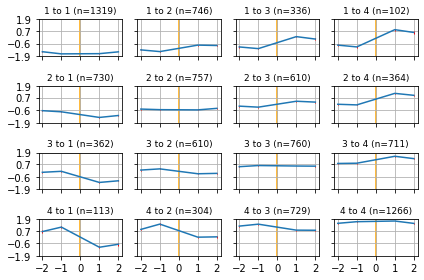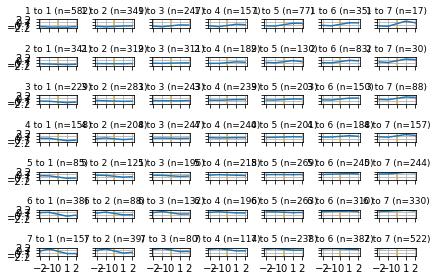Card-Heining-Kline event study example
[1]:
# Add PyTwoWay to system path (do not run this)
# import sys
# sys.path.append('../../..')
Import the PyTwoWay package
Make sure to install it using pip install pytwoway.
[2]:
import pytwoway as tw
import bipartitepandas as bpd
Get your data ready
For this notebook, we simulate data.
[3]:
df = bpd.SimBipartite().simulate()
display(df)
| i | j | y | t | l | k | alpha | psi | |
|---|---|---|---|---|---|---|---|---|
| 0 | 0 | 81 | 0.283938 | 0 | 2 | 4 | 0.000000 | -0.114185 |
| 1 | 0 | 81 | -1.613504 | 1 | 2 | 4 | 0.000000 | -0.114185 |
| 2 | 0 | 175 | 1.057488 | 2 | 2 | 8 | 0.000000 | 0.908458 |
| 3 | 0 | 45 | 0.894313 | 3 | 2 | 2 | 0.000000 | -0.604585 |
| 4 | 0 | 90 | 1.122351 | 4 | 2 | 4 | 0.000000 | -0.114185 |
| ... | ... | ... | ... | ... | ... | ... | ... | ... |
| 49995 | 9999 | 2 | -2.978308 | 0 | 0 | 0 | -0.967422 | -1.335178 |
| 49996 | 9999 | 2 | -2.532244 | 1 | 0 | 0 | -0.967422 | -1.335178 |
| 49997 | 9999 | 14 | -2.428863 | 2 | 0 | 0 | -0.967422 | -1.335178 |
| 49998 | 9999 | 14 | -0.928106 | 3 | 0 | 0 | -0.967422 | -1.335178 |
| 49999 | 9999 | 21 | -3.030404 | 4 | 0 | 1 | -0.967422 | -0.908458 |
50000 rows × 8 columns
Prepare data
This is exactly how you should prepare real data prior to generating the CHK plot.
First, we convert the data into a
BipartitePandas DataFrameSecond, we clean the data (e.g. drop NaN observations, make sure firm and worker ids are contiguous, etc.)
Third, we cluster firms by the quartile of their mean income, to generate firm classes (columns
g1andg2). Alternatively, manually set the columnsg1andg2to pre-estimated clusters (but make sure to add them correctly!).Fourth, we convert the data into extended event study format
Further details on BipartitePandas can be found in the package documentation, available here.
Note
In general, the CHK event study is generated by clustering the data using quartiles of firm-level mean income.
[4]:
measures = bpd.measures.Moments(measures='mean')
grouping = bpd.grouping.Quantiles(n_quantiles=4)
cluster_params = bpd.cluster_params(
{
'measures': measures,
'grouping': grouping
}
)
bdf = bpd.BipartiteDataFrame(
i=df['i'], j=df['j'], y=df['y'], t=df['t']
) \
.clean() \
.cluster(cluster_params) \
.to_extendedeventstudy(transition_col='j', periods_pre=2, periods_post=2)
checking required columns and datatypes
sorting rows
dropping NaN observations
generating 'm' column
keeping highest paying job for i-t (worker-year) duplicates (how='max')
dropping workers who leave a firm then return to it (how=False)
making 'i' ids contiguous
making 'j' ids contiguous
computing largest connected set (how=None)
sorting columns
resetting index
Creating CHK event study plot
Once the data is cleaned, clustered, and in extended event study form, we can generate the event study plots.
[5]:
tw.diagnostics.plot_extendedeventstudy(bdf, periods_pre=2, periods_post=2)

Warning
Be careful not to include too many clusters!
[6]:
measures = bpd.measures.Moments(measures='mean')
grouping = bpd.grouping.Quantiles(n_quantiles=7)
cluster_params = bpd.cluster_params(
{
'measures': measures,
'grouping': grouping
}
)
bdf = bpd.BipartiteDataFrame(
i=df['i'], j=df['j'], y=df['y'], t=df['t']
) \
.clean() \
.cluster(cluster_params) \
.to_extendedeventstudy(transition_col='j', periods_pre=2, periods_post=2)
tw.diagnostics.plot_extendedeventstudy(bdf, periods_pre=2, periods_post=2)
checking required columns and datatypes
sorting rows
dropping NaN observations
generating 'm' column
keeping highest paying job for i-t (worker-year) duplicates (how='max')
dropping workers who leave a firm then return to it (how=False)
making 'i' ids contiguous
making 'j' ids contiguous
computing largest connected set (how=None)
sorting columns
resetting index
